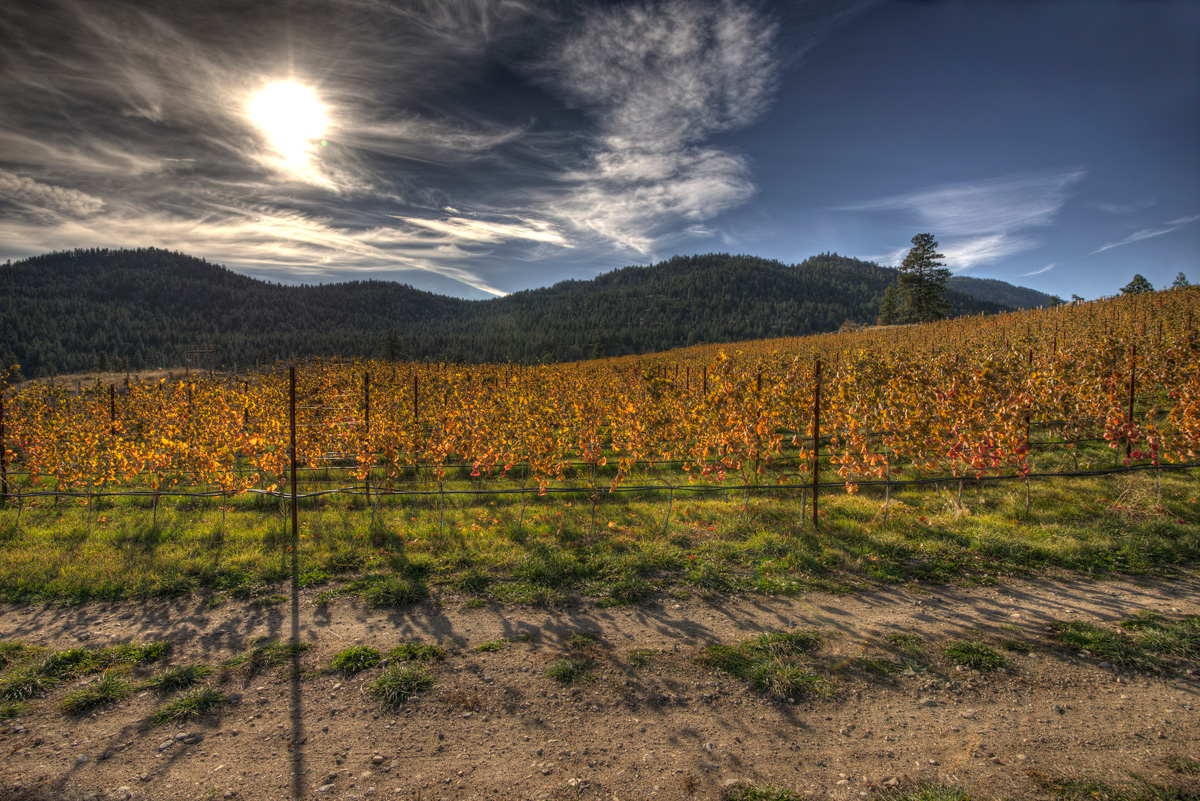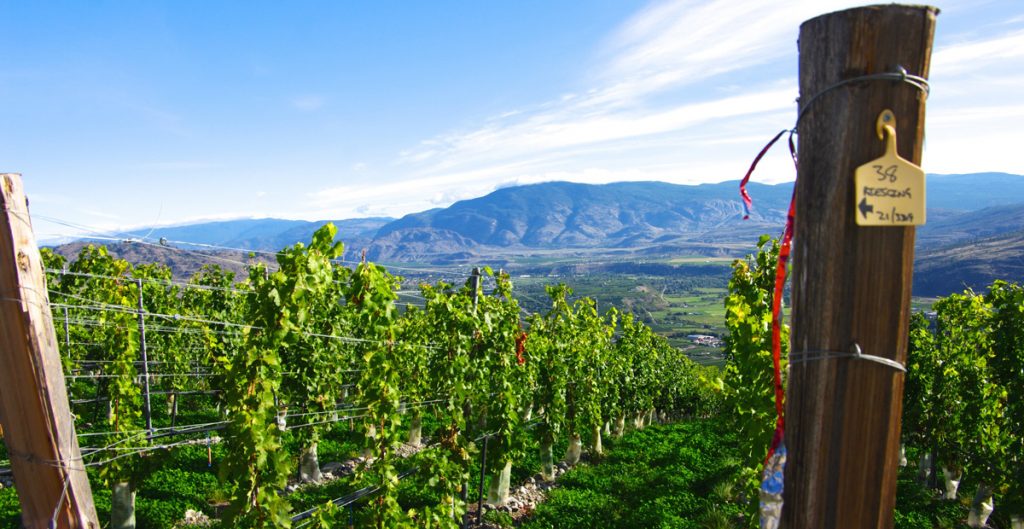
Wine Culture Magazine

At elevations up to 680 metres, Haywire winery’s Garnet Valley Ranch vineyard is among the highest in B.C. Photo courtesy of Haywire
Things are on the up and up in the Okanagan Valley. Literally.
It’s no secret that due to any number of factors—from climate change to spiralling land costs—wineries around the world are planting vineyards higher than ever before. Argentina in particular has enjoyed success from vineyards as high as 2,500 metres in elevation. Its MAS program even puts the elevation right on the label in “Metres Above Sea Level.”
In borderline ripening Canada, such oenological dalliances would once have been unthinkable—at least until a few years ago. Even in neophyte B.C., most wine growers understood it wasn’t a good idea to plant on the valley floor, the low levels to which vine-killing frosts are drawn, but higher sites were considered too cold and short-seasoned. Hence B.C.’s modern industry has been built on the benches, throughout the Okanagan and Similkameen valleys.
At this altitude, the soils are more interesting, the season is shorter and more intense and the temperatures cooler.
However, there were exceptions. Storied SYL Ranch (formerly Hawthorne Mountain Vineyards and LeCompte) owes its existence to an eccentric British army major who figured planting hybrid grapes at 600 metres would be just fine. As it turns out, he was right. When pioneering Harry McWatters purchased the property, he planted Gewürztraminer, among other grapes. Those vineyards have produced some pretty good wines and plans are afoot to develop them further.
When in 2011 Christine Coletta and Steve Lornie unveiled Haywire and Okanagan Crush Pad, they introduced consulting oenologist Alberto Antonini, who outlined the new winery’s philosophy of minimal intervention, including adopting concrete over oak, and why that would happen. (Also present was the first concrete egg in Western Canada.) Missing was Antonini’s business partner, soil specialist Pedro Parra, who was likely busy digging his celebrated soil pits elsewhere. As they have others globally, Antonini and Parra instilled in the winery the need to above all respect the soils and make wines that reflect the terroir. It also inspired them to push their grape-growing boundaries.
Says Coletta: “Around the world, growers are looking at the hills and mountains as the future place for ultra-premium wine. The search for land where we could employ ‘extreme viticulture’ [a phrase coined by Parra] resulted in our purchase of 320 acres of raw land, Garnet Valley Ranch, in 2012. Today, vineyards sit between 600 and 680 metres above sea level in several blocks.
“At this altitude,” she adds, “the soils are more interesting, the season is shorter and more intense and the temperatures cooler. We see strong phenolic ripeness at lower sugar levels and, in the resulting finished wines, lower alcohol levels, better acidity and balance.”
It’s also a spectacular setting, one of the highest plantings to date in the valley. And the winery’s organic Garnet Valley Pinot Noir is already turning heads.

Don Triggs of Culmina Family Estate was searching for a site that would provide more complexity when he discovered the 595-metre-high Margaret’s Bench vineyard near Oliver. Tim Pawsey photo
After Don Triggs retired from his successful career at Vincor, and the Triggs family moved west from Niagara, they also went looking for sites that would yield more complex wines. While they purchased virgin property on which to establish Culmina Family Estate, south of Oliver, they decided to add a much higher site, Margaret’s Bench, at 595 metres.
“Our motivations were centred around finding an ideal for growing top-quality cool- climate white varieties (Chardonnay, Riesling and Grüner Veltliner),” says Sara Triggs.
You get excellence from vines when they’re on the margins.

Culmina’s Margaret’s Bench not only grows wines of subtle complexity, it also offer s spectacular views of the valley. Tim Pawsey photo
“We had two choices: to go further north, or further ‘up.’ We chose the latter, following extensive terroir study on the site which validated its suitability for the varieties that we were hoping to plant.”
Indeed, their planting of Grüner Veltliner is already showing great promise, as well as some similarities to Austrian “terrassen” wines.
When Terry and Andrew Meyer Stone were seeking a property, they were drawn to Osoyoos, “because it had the most frost-free days,” says Andrew. Little did they expect to buy a neglected vineyard at 520 metres, halfway up the corkscrew road that climbs formidable Anarchist Mountain just east of town. The couple admit they were seduced by the panoramic views. While at first concerned by the elevation, in talking to others they became convinced that Anarchist Vineyard was not only feasible but desirable.
“Taking risks is all part of the program. Plus I wanted to learn,” says Andrew. “I wanted to push the envelope—and to make wine that I liked… to be different and appeal to a niche market.”
The bottom line?
“You get excellence from vines when they’re on the margins.”
Aiming for altitude may be new in B.C., but several wine regions around the world have already scaled the lofty heights. Here are some of the world’s highest vineyards:
Quebrada de Humahuaca GI, Argentina: elevation 3,329 metres above sea level
Hess Family Estates Altura Maxima, Salta, Argentina: 3,111 m
Ao Yun, Meili Snow Mountain, China: 2,600 m
Fox Fire Farms, Ignacio, Colorado: 1,975 m
Bodega Frontos, Tenerife, Canary Islands: 1,700 m
In B.C.:
Larch Hills Winery, Salmon Arm: 700 m
Haywire, Garnet Valley, Summerland: 680 m
See Ya Later Ranch, Okanagan Falls, B.C.: 610 m
Culmina Family Estate’s Margaret’s Bench, Oliver:
595 m
Anarchist Vineyard, Anarchist Mountain, Osoyoos: 520 m

Tim Pawsey writes and shoots at hiredbelly.com as well as for publications including Quench, TASTE and Montecristo. He’s a frequent wine judge and is a founding member of the B.C. Hospitality Foundation.

Tim Pawsey writes and shoots at hiredbelly.com as well as for publications including Quench, TASTE and Montecristo. He’s a frequent wine judge and is a founding member of the B.C. Hospitality Foundation.
Copyright © 2025 - All Rights Reserved Vitis Magazine